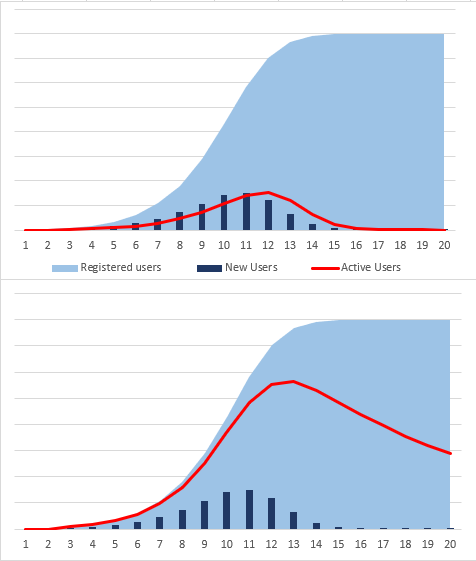- ARPDAUPosted 13 years ago
- What’s an impressive conversion rate? And other stats updatesPosted 13 years ago
- Your quick guide to metricsPosted 13 years ago
Call them back – part 2 of Dating Strategies for Player Retention
This is the second guest post in a series from John Cheng of Playnomics. To see the first post, go and read How to ask someone out.
Winback: Retargeting Your Users to Increase Returns
While the first session experience is important, the actions you take following that engagement are often equally, if not even more critical. A player may have a great first go-round, but then upon returning to the real world, encounters a multitude of distractions ripe for causing your game to slip from their mind. Forget competition from other games, you’re asking for a player’s time and energy and that means you’re competing with, oh, EVERYTHING ELSE a person might do.
In a romantic courtship, everyone knows that the real indicator of a first date’s success is whether or not a follow-up call is made the next day (or next 48 hours, to be generous). For game publishers, the bachelors/suitors of any player retention courtship, every first date warrants the follow-up call and then some… a substantial more “some” actually.
This is the time to nurture a player’s habits specific to your game. Unless and until you do that, your budding new relationship is at risk. “Nurturing sounds hard. How does that work?” Like a charm.
Nurturing new player relationships requires finesse, yes, but the core concepts are simple:
- Proactively retarget players on the web
- Don’t tell players what to do; motivate them to do it (plant the seed)
- Continue driving messages to retain engagement
In this critical period, you must continue to drive messaging to new players that will cause them to engage with your game. However, the opportunity to speak to them in game is not necessarily something you can control. Rather, this is the time to be proactive. You’ve got to go out into the wild blue Internet, find these players wherever they are, and reinforce the goodwill you’ve created through their gameplay experience thus far. This approach might be creepy for a romantic suitor, but for game publishers it’s neither creepy nor weird; proactively communicating with new players through various online channels is very much recommended. Be persistently interesting and stay top of mind, or risk losing your players to another bachelor. If you don’t do it, someone else will.
The best performing retention messages are uniquely targeted to individual player segments. Is this someone who didn’t finish the tutorial? Bring them back with a promise of increased guidance. Did this segment of players really enjoy the PvP feature of your game in that first session? Target them with new players to challenge. Each of these examples importantly follows the key rule of customer retention: don’t tell players to do something, motivate them to do it.
Now, you can do this manually, pixeling every new account and showing the same web ads across the new player gamut… And while that type of one-size-fits-all approach is basic (perhaps even lame), here’s the funny part: even it performs well. In other words, any halfwit approach to retention messaging will yield results (better than nothing, at the very least); this is why every successful publisher invests resources in retention — because it’s an unbelievably effective tool for engaging players, early and often throughout their lifecycle.
For something so effective and important to your bottom line as retention messaging, it’s not good enough to settle for a good-enough, one-size-fits-all line of fire… You want the bestretention messaging (unless you hate money), so you need to uniquely target individual player segments, early and forevermore… end of story.
Take advantage of retargeting technology to keep your game front and center and bringing undecided players back when they’re ready to play. Every time a player sees your retargeting ads, your game gains traction and more recognition; as a result, the likelihood of long-term loyalty and monetization from that player goes up. The high click-through rates and increased conversions that are typical with retargeting campaigns underscore the value of good branding and repeated exposure.












